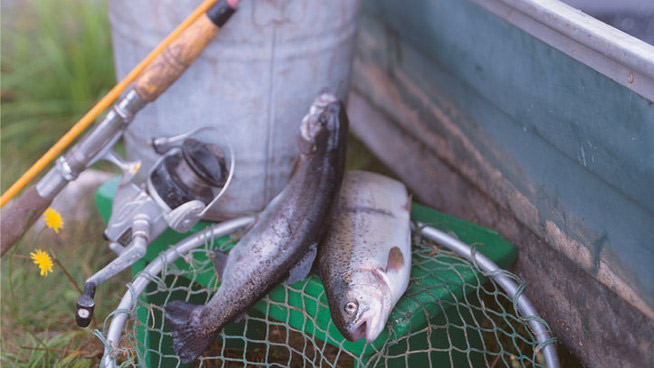Beware of mercury!
Industrial and agricultural pollution is largely responsible for the contamination of waterways and the fish that inhabit them. The contamination varies significantly depending on the elements present, various fish species, their age, size and fishing grounds. Mercury is the most worrisome.
If ingested in large amounts over a long period of time, it can affect the immune system and damage the nervous system, especially coordination and the senses of touch, taste and sight. It is extremely dangerous for foetuses, newborns and young children with fast-developing nervous systems.
The fish with the highest infection rates are mostly older and larger: pike, walleye, muskie, bass and lake trout. Why? They are piscivorous, that is to say fish-eating fish.
Pregnant women: exercise extreme caution!
As embryos and infants are very vulnerable to the effects of mercury, pregnant or nursing mothers should take extra precautions. It is recommended they regularly eat fish that is less likely to be contaminated (the first group in the table at the end of this article). Species in the second group should be consumed occasionally (less than once a month), while it is best to avoid species in the last group altogether.
PCBs and company
If ingested in large amounts over a long period of time, other contaminants such as PCBs, DDT, dioxins and furans are believed to cause skin diseases, liver damage, immune and reproductive system damage, and possibly cancer. Generally, viscera, fat and skin are the preferred sites for contaminants. It is best to avoid eating fish skin, even when it is well cooked and crispy.
Recommendations for fish consumption
Government agencies have issued consumption advisories that apply to fish caught recreationally and those from fish farms. They are based on a 250 g (8 oz) serving of fresh fish (before being cooked) per meal. If you only eat half that amount, you can double the recommended frequency of consumption.
I've got a bite!
What do you do after you take your catch out of the water? Here are three recommendations from the Quebec Ministry of Agriculture, Fisheries and Food (MAPAQ) to safely store fish.
- Fish becomes a perishable food when it is no longer living. It must be placed on ice or ice packs in a cooler. Don't put it in the bottom of the boat or on a water boiler; it won't be cold enough. It is also not recommended to hang fish on a chain and return to the water as the surface of the water is not cold enough.
- Gut the fish as soon as possible. Before you start, make sure to wash your hands and clean the work surface.
- Fish must be refrigerated as soon as it is gutted (between 0 °C and 4 °C). If you don't plan to eat the fish within 24 hours of catching it, stick it in the freezer.
To the table!
Now it's time to enjoy your catch. Although there is a sushi, carpaccio and tartare trend in full swing, MAPAQ recommends you avoid making them with fish caught during recreational fishing. This way, you avoid the risk of parasite contamination. Some species, including walleye, northern pike, bass, bluegill, perch, trout and char, are often infected. However, cooking fish to allow its flesh to reach a temperature of 60 °C (115 °F) will eliminate any risk of contamination. The preferred preparation method is definitely cooking. Hot smoking is another possibility, if the temperature reaches at least 60 °C. It should be noted that lemon and lime juice change the flesh's texture but do not cook it and so do not eliminate the risk of contamination.
Before you head out fishing…
Health Canada states: "Most Canadians don't need to be concerned about mercury exposure as a result of fish consumption." For more information about mercury in fish, consult the Mercury in Fish document on the Health Canada website. It offers consumption advice so you can make informed choices about the fish you eat.
Recommendations for fish consumption
Species to eat with no limit:
- Canned tuna
- Cod
- Mussels
- Pollock
- Rainbow Smelt
- Salmon
- Scallops
- Shrimp
- Sole
- Tomcod
- Trout (excluding lake trout)
- Whitefish
Once a month for pregnant or nursing women, women of child-bearing age and young children. Once a week for others:
- Bluefin Tuna
- Bluegill
- Bullhead
- Burbot
- Miller
- Perch
- Shark Sturgeon
- Swordfish
To be avoided by pregnant and nursing mothers and young children. Two times a month for others.
- Bass
- Pike
- Muskie
- Trout (Salmon trout)
- Walleye
